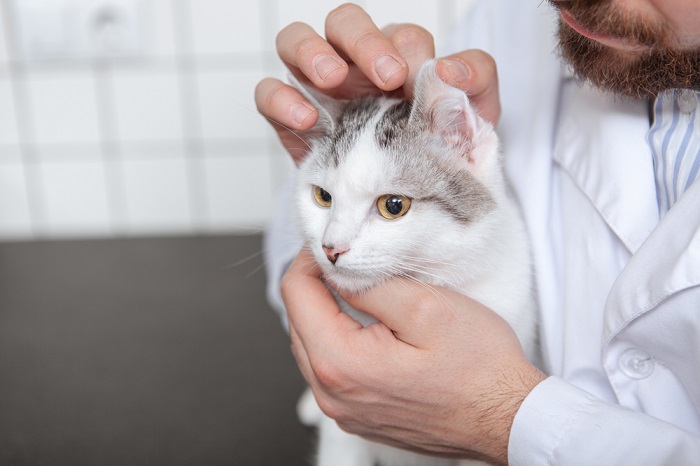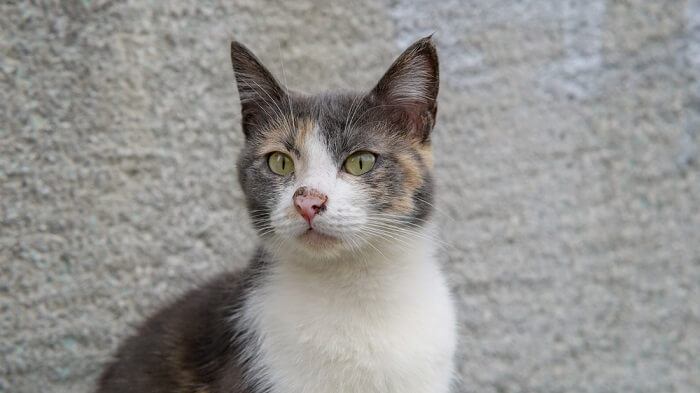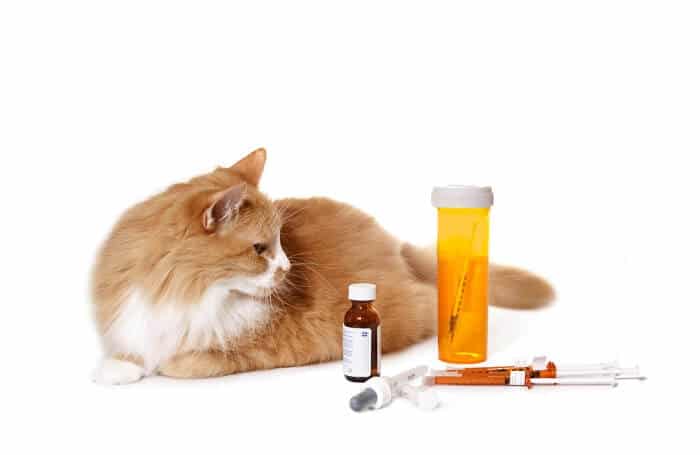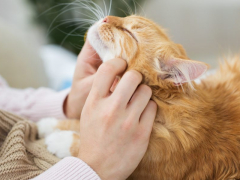
Doxycycline is a broad-spectrum antibiotic commonly used to treat certain bacterial infections in cats. In this article, you’ll learn more about doxycycline, what types of infections it may be indicated for, side effects, administration tips, frequently asked questions, and more.
Doxycycline for Cats Overview

About Doxycycline for Cats

Doxycycline is a tetracycline antibiotic. Tetracyclines are generally time-dependent bacteriostatic antibiotics. This means that the length of time they are employed against bacteria susceptible to them is most important.
Although termed “bacteriostatic”, implying they only inhibit the growth of bacteria, antibiotics like doxycycline do actively kill bacteria. They simply require a higher concentration than an antibiotic labeled as “bactericidal”. Thus, for bacteria that are equally susceptible to them, doxycycline is not necessarily a “weaker” or “less effective” antibiotic than a bactericidal agent like amoxicillin.
Doxycycline is used to treat a variety of infections in cats, predominantly infections of the upper respiratory tract and infections caused by certain bacteria commonly transmitted by fleas and ticks.
What Does Doxycycline Do for Cats?

As with most antibiotics, doxycycline has good levels of efficacy against certain bacteria, while others may be resistant or just not susceptible to it.
For example, an upper respiratory infection in a cat caused by bacteria including Bordetella, Chlamidophila (Chlamydia), or Mycoplasma will typically be susceptible, while a urinary tract infection caused by Proteus is unlikely to be.
Doxycycline also is not effective against viral causes of upper respiratory infections in cats, like feline herpesvirus and calicivirus, which are actually by far the most common underlying causes in kitties.
Doxycycline is commonly used to treat infections caused by bacteria transmitted to cats from fleas and ticks. These can include organisms like Anaplasma, Ehrlichia, Bartonella, and Mycoplasma hemofelis (not to be confused with our Mycoplasma involved with upper respiratory infections).
Doxycycline is also effective against a bacteria called Wolbachia. Killing Wolbachia bacteria in dogs has been demonstrated to weaken heartworms, the cause of mosquito-borne heartworm disease. This effect has not been definitively proven in cats and is still being studied, though some veterinarians may employ doxycycline in treating cats with heartworm disease for this reason.
Side Effects of Doxycycline for Cats

The main side effect of doxycycline in cats is gastrointestinal upset, so giving them Doxycycline with food should help to reduce this risk.
The main side effect of doxycycline in cats, as with many antibiotics, is gastrointestinal upset, including vomiting, regurgitation, diarrhea, and a decrease in appetite.
Doxycycline should always be given with food, as this can help to reduce the chance of digestive upset.
In cats, administration of plain doxycycline tablets on their own carries a very high risk for esophagitis, ulcerations, and a narrowing of the esophagus called a stricture. In fact, the risk for cats is considered so high that many veterinarians will avoid use of the tablets in cats and opt for having doxycycline compounded into a liquid form.
When given to pregnant dogs and cats in earlier stages of pregnancy, tetracyclines in general can slow down fetal skeletal growth and discolor their teeth. Doxycycline however is the least likely of the tetracyclines to have these effects.
Unlike other tetracycline antibiotics, doxycycline can be used in pets with kidney disease. However, it should be used cautiously in cats with liver disease or elevated liver values on lab work.
Doxycycline for Cats Dosage

There is no labeled dosage for Doxycycline, but there are commonly accepted dosages for certain infections. Always consult a vet before giving a drug to your cat.
Because the use of doxycycline is off-label when treating infections in pets, there is no labeled dosage. There are commonly accepted dosages for certain infections, but some veterinarians may differ on prescribing once a day, twice a day, or for how long depending on the infection and circumstance. Always make sure to closely follow your veterinarian’s instructions.
An important note about dosing cats is that there is a high risk for kitties developing irritation and ulceration of the esophagus (termed esophagitis) and narrowing/tightening of the esophagus which is called an esophageal stricture.
For this reason, many veterinarians will prefer to have doxycycline compounded into a flavored liquid preparation for their feline patients.
If tablets must be used, direct administration should be followed by at least 6ml (roughly a teaspoon) of water to ensure that the tablet makes it all the way down to the stomach. Although doxycycline should be given with food to offset digestive upset, hiding the tablet in food and hoping it makes its way down may be less effective than ensuring its passage with a small amount of water.
As you can imagine, administering a pill to a cat and then trying to syringe water on top of that can be a real headache for you and your kitty. This is another reason a liquid form ordered from a compounding pharmacy can be easier and more successful to use.
Conclusion

Doxycycline is an effective antibiotic for certain types of infections, and certainly deserves its place as an important one to use in cats. A big takeaway is the need to reduce the risk of esophageal damage in cats caused by a dry pill getting lodged as it can be very irritating and lead to strictures. Using a compounded liquid form of the medication is generally recommended.
Another big takeaway is to remember that while it is used often for bacterial upper respiratory infections in cats, most URIs in cats are caused by viruses, not bacteria, and doxycycline cannot be used to treat these viral infections. That’s why it’s always very important for your veterinarian to decide if using antibiotics is appropriate.
Frequently Asked Questions
How long does it take doxycycline to work in cats?
With most antibiotics treating susceptible organisms, improvements should be seen within 2-3 days, although the full resolution of signs often takes longer. This is why it is very important to finish out all of an antibiotic prescribed by your veterinarian. Do not stop using doxycycline or any other antibiotic based on your cat looking or feeling better.
What is the best antibiotic for feline upper respiratory infection?
The true answer is whatever antibiotic the bacteria involved in the infection are most susceptible to! This is sometimes easier said than done.
But it is important to remember that a large majority of upper respiratory infections in cats are caused by viruses like herpesvirus and calicivirus, not by bacteria. So in many cases, an antibiotic may not be indicated at all.
If your veterinarian does suspect a bacterial infection is involved, he or she may choose an antibiotic based on the likelihood of certain organisms being present. Bordetella and Chlamydophila (Chlamydia) for example, are common bacterial causes of URI's, and both are very susceptible to a number of antibiotics, including doxycycline. Sometimes, nasal swabs may be collected to run additional testing to try to determine a causative organism. But because these panels can be expensive and difficult to interpret, they are not employed often.
Is doxycycline a powerful antibiotic?
Although we sometimes throw around terms like “big gun” when it comes to antibiotics, we should get away from this mentality. Even newer generation antibiotics can have bacteria resistant to them.
Doxycycline is an effective antibiotic against most of the bacteria typically susceptible to it. Veterinarians typically determine antibiotic use based on bacterial culture whenever possible or at least based on the likelihood of infectious organisms present, and the body system affected.
For example, while doxycycline can have a high level of success for a bacterial upper respiratory infection in a cat, it will likely do very poorly if used for a urinary tract infection because the types of bacteria found in each case are different.
And although doxycycline is a bacteriostatic antibiotic, it is not necessarily “weaker” than a bactericidal antibiotic like amoxicillin. Bacteriostatic antibiotics do kill bacteria, they simply require a higher concentration to do so.
A 2018 study in Clinical Infectious Diseases comparing bacteriostatic and bactericidal antibiotics in people highlights this distinction. Researchers found that not only were bacteriostatic and bactericidal antibiotics about equivalent in efficacy most of the time, but that in cases where there was a difference, bacteriostatic antibiotics often appeared superior and more cost effective.








Where is research using doxycycline in cats with lymphomic cancer?
Hi Marianne,
Doxycycline is not used primarily for treatment of lymphoma in cats (or other species to my knowledge). In doing a quick peer-reviewed article search, I did not see any studies evaluating doxycycline use for lymphoma either.
Doxycycline does have anti-inflammatory and immunomodulatory properties, so it’s possible there may be some cases where a doctor may find it advantageous to use, even if it’s not functioning as a primary treatment.
There are also cases where doxycycline may be used to control secondary bacterial infections in cases where lymphoma is also present. Examples could include cases of cutaneous (skin) lymphoma as well as lymphoma in the nasal passages or sinuses, where secondary bacterial overgrowth and related complications can be common.